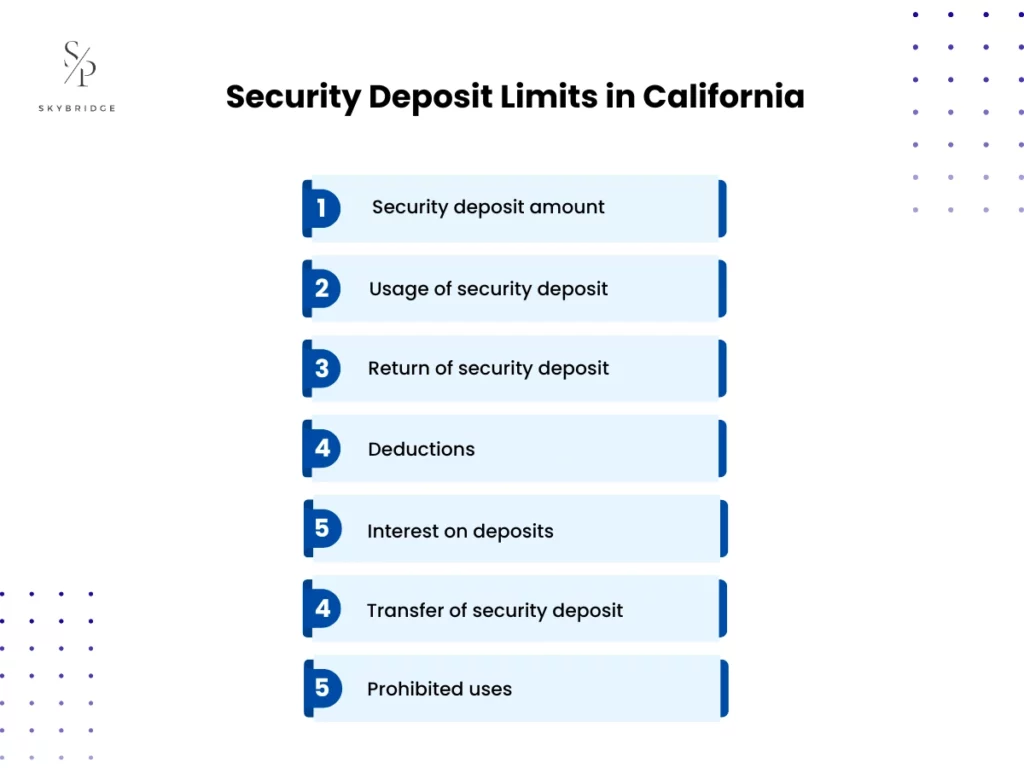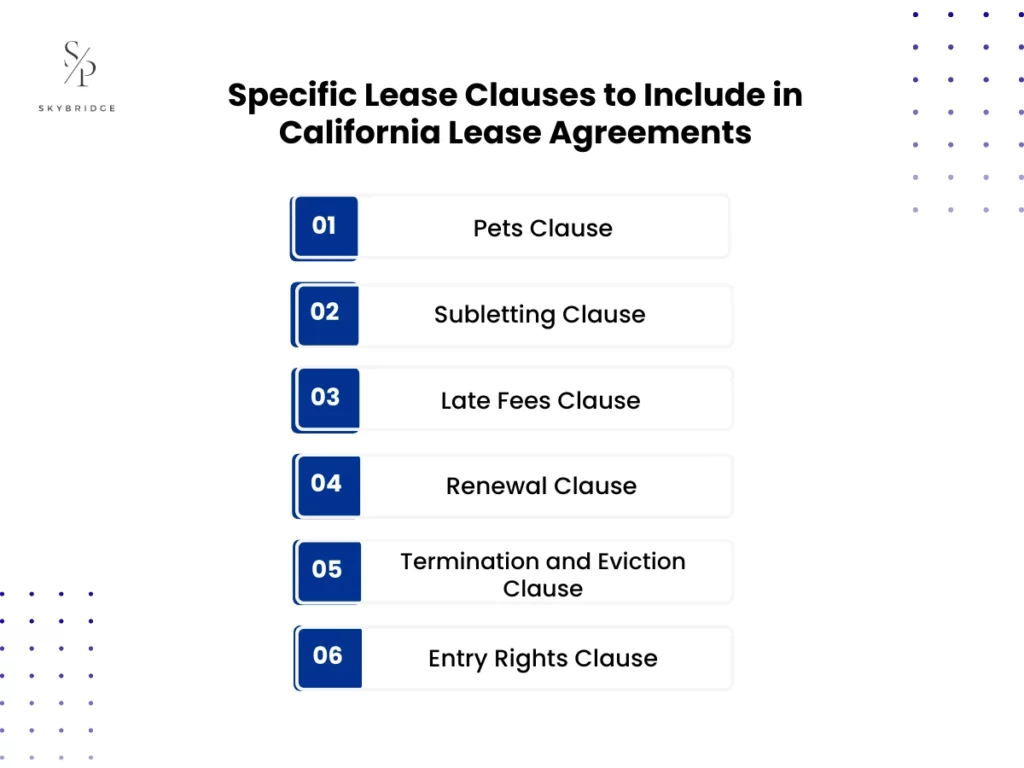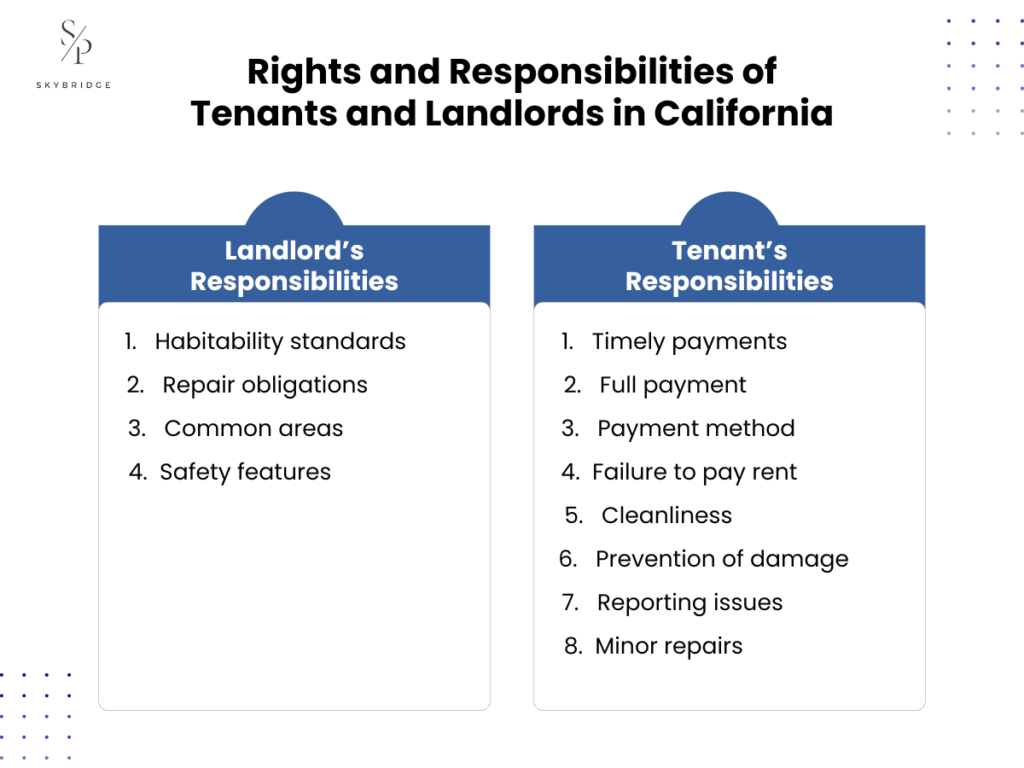A California lease agreement is a legal contract that protects both landlords and tenants by clearly outlining rental terms, responsibilities, and rights. To ensure that the lease is legally sound and prevents future disputes, it is crucial to include all necessary clauses that comply with California’s complex rental laws. Without a detailed, well-structured agreement, both parties could face confusion or even legal issues down the line.
This California Lease Agreement Checklist will guide you through the essential components that every lease should have. From rent payment terms and security deposit rules to maintenance responsibilities and eviction procedures, this checklist ensures that both landlords and tenants fully understand their obligations and protections.
Whether you are a landlord creating a lease agreement or a tenant reviewing the terms, this guide provides clarity on what needs to be included to protect everyone involved. Following this checklist will help you draft a comprehensive lease that complies with California’s legal standards, covers critical areas such as tenant rights and property maintenance, and avoids common legal pitfalls.
What is a Lease Agreement Checklist?
A lease agreement checklist is a detailed document that outlines the essential elements, like rent terms, maintenance responsibilities, security deposits, and tenant rights. It serves as a guide to ensure that all critical aspects of a rental agreement are addressed and comply with legal requirements, helping both landlords and tenants avoid future conflicts or misunderstandings.
This checklist is especially important in California, where rental laws can be intricate and vary by region. By using a checklist, you can ensure that your lease agreement covers all necessary clauses, keeping both parties informed and legally protected.
Key items covered in the checklist include:
- Rent and payment terms: Outlining the amount, due dates, and accepted payment methods.
- Lease duration: Defining the rental period and whether it is month-to-month or fixed-term.
- Maintenance responsibilities: Detailing who is responsible for property upkeep and repairs.
- Security deposit details: Stating the amount, purpose, and conditions for returning the deposit.
- Tenant’s rights and obligations: Clarifying privacy, maintenance duties, and other responsibilities.
- Landlord’s responsibilities: Ensuring the property is habitable and addressing major repairs.
- Renewal and termination terms: Specifying how the lease can be renewed or terminated, along with notice periods.
- Pet policies (if applicable): Outlining whether pets are allowed and any restrictions or requirements.
- Subletting rules: Detailing whether subletting is permitted and any specific conditions.
- Entry rights and notice requirements: Defining when and how a landlord may enter the property.
- Eviction procedures: Clarifying the process and conditions under which eviction may occur.
- Insurance requirements (if applicable): Specifying any insurance coverage required for the property or tenants.
By following this checklist, landlords can ensure their lease agreements are thorough and compliant with California’s rental laws, while tenants gain clarity on their rights and obligations. A well-crafted lease agreement reduces the risk of legal disputes and helps maintain a positive rental relationship.
Lease Agreement Types in California
In California, lease agreements primarily fall into four categories: residential leases, commercial leases, month-to-month leases, and fixed-term leases. Each type differs in its duration, flexibility, and legal requirements, and understanding these differences is crucial for both landlords and tenants. The following sections will dive deeper into the specifics of each lease type and what to consider when selecting the right one for your rental needs.
Residential Lease
A residential lease in California is a legal contract for renting properties such as apartments, houses, or condominiums. While most leases are fixed for 12 months, month-to-month leases are also common for flexibility. In California, residential leases must adhere to specific legal requirements, including those outlined in the California Tenant Protection Act (AB 1482), which limits rent increases and provides eviction protections.
Key components of a California residential lease include:
- Lease duration: Typically 12 months, but can be month-to-month.
- Rent terms: Includes the rent amount, due date, and accepted payment methods, with adherence to California rent control laws.
- Maintenance responsibilities: Outlines the landlord’s obligation to meet habitability standards and the tenant’s role in maintaining the property.
- Security deposit: Cannot exceed two months’ rent for an unfurnished unit, and three months’ rent for a furnished unit. The deposit must be returned within 21 days of move-out, along with an itemized statement of any deductions.
- Pet policies: Specifies pet allowances and restrictions, in compliance with California laws. Landlords can set their own pet rules, but must follow state limits on security deposits and federal laws protecting tenants with service animals or emotional support animals (ESAs).
- Tenant rights: Includes privacy, protection from unlawful eviction, and rights under the California Tenant Protection Act.
- Termination and renewal terms: Defines the notice period for lease termination or renewal, with California requiring 30 days’ notice for month-to-month leases.
Commercial Lease
A commercial lease is an agreement used for renting business properties, such as office spaces, retail stores, or industrial units. In California, these leases are typically longer-term than residential leases, often ranging from 3 to 10 years, and they involve more complex terms to accommodate the needs of businesses. Commercial leases generally include clauses that outline the rent amount, lease duration, maintenance responsibilities, and other operational requirements.
Key components of a California commercial lease include:
- Lease duration: Typically longer than residential leases, often 3 to 10 years.
- Rent terms: California commercial leases often use a Triple Net (NNN) structure, where tenants pay base rent plus additional costs like property taxes, insurance, and maintenance fees. Rent escalations are common, typically tied to inflation or set intervals.
- Maintenance responsibilities: Usually, tenants are responsible for maintaining the interior of the property, while landlords handle structural repairs and the exterior. This is often detailed in NNN leases to clarify responsibilities.
- Security deposit: Security deposits for commercial leases in California can be as high as six months’ rent, reflecting the higher value and risks associated with commercial properties.
- Right of Entry: Landlords in California have the right to enter the property in case of an emergency, but for normal repairs or inspections, they must provide the tenant with at least 72 hours’ notice.
- Permitted use: Commercial leases in California specify how a property can be used to ensure compliance with local zoning laws, health codes, and business needs. Tenants must align their use with the property’s zoning designation.
- Tenant improvements: Defines what alterations, if any, tenants are allowed to make to the property, often negotiated in the lease.
- Insurance requirements: Require tenants to maintain a Comprehensive General Liability (CGL) policy and casualty insurance, both issued by an AAA-rated insurance company. The landlord must be named as an additional insured on these policies.
Month-to-Month Lease
A month-to-month lease, also known as periodic tenancy, is a rental agreement (30-day contract) that automatically renews each month until either the landlord or tenant decides to terminate it. This type of lease is common in California for short-term rentals or situations where the tenant or landlord prefers flexibility without committing to a long-term lease.
Key components of a California month-to-month lease include:
- Lease duration: The lease renews automatically each month unless either party provides notice to terminate. This is also referred to as periodic tenancy, where the rental period is indefinite but continues periodically (monthly).
- Rent terms: Rent is paid monthly, and the landlord can increase the rent with proper notice, typically 30 days for increases under 10% and 60 days for those over 10%, in compliance with California’s rent control laws if the property is rent-controlled.
- Termination terms: Either party can terminate the lease with a 30-day notice if the tenant has lived in the unit for less than one year, or 60 days if the tenant has been there for one year or more. These terms comply with California’s legal requirements for terminating periodic tenancies.
- Flexibility: The month-to-month lease offers flexibility for both parties, allowing either the landlord or tenant to make changes, such as rent increases or lease termination, with short notice.
- Eviction protections: Even under a month-to-month lease, tenants in California are protected by the California Tenant Protection Act (AB 1482), which limits evictions to just causes and requires following proper legal procedures.
Fixed-Term Lease
A fixed-term lease is a rental agreement with a set duration, typically 12 months, that defines the terms of the lease for the entire period. This type of lease offers stability for both tenants and landlords, as the terms, including rent and responsibilities, are locked in for the agreed-upon duration.
Key components of a California fixed-term lease include:
- Lease duration: Typically set for 12 months, but it can vary. The lease automatically ends after the term unless both parties agree to renew or extend it.
- Rent terms: Rent is fixed for the lease term, providing predictability. Rent increases can only occur at the end of the term upon renewal or renegotiation.
- Maintenance responsibilities: The landlord is responsible for major repairs and ensuring the property meets habitability standards. Tenants are responsible for maintaining the property in good condition and performing routine upkeep.
- Security deposit: The security deposit cannot exceed two months’ rent for an unfurnished unit or three months for a furnished unit. It must be returned within 21 days of move-out, with an itemized statement detailing any deductions.
- Renewal and termination: The lease may be renewed or converted to a month-to-month lease if the tenant stays after the term ends. In California, for month-to-month leases, 30 days’ notice is required for tenants under one year, and 60 days’ notice for tenants over one year.
- Tenant rights: Tenants are entitled to legal protections under California law, including the right to a habitable living space, privacy, and protection against unfair eviction practices.
Legal Requirements for Lease Agreements in California
To ensure compliance and fairness, lease agreements in California must adhere to California Civil Code Section 1940-1954, Rent Control Ordinances, Security Deposit Limits in California, Fair Housing Laws in California, and Required Disclosures in California Lease Agreements. These legal requirements ensure fairness, protect tenant rights, and define the responsibilities of both parties in the rental agreement. Adhering to these standards helps prevent legal disputes and ensures the lease is legally valid and enforceable.
California Civil Code Section 1940-1954
The provisions under California Civil Code Sections 1940-1954 govern key aspects of rental agreements, ensuring that both tenants and landlords in California adhere to fair practices and legal standards. These sections outline tenant rights, landlord responsibilities, and the legal procedures that must be followed to maintain a safe and lawful rental environment.
Key provisions of California Civil Code Section 1940-1954 include:
- Tenant rights: Tenants are entitled to quiet enjoyment of the property, meaning they have the right to occupy the rental unit without interference or harassment from the landlord. Landlords cannot use threats or intimidation to force tenants to vacate.
- Landlord responsibilities: Landlords must ensure that the property complies with habitability standards, which include providing safe plumbing, heating, and electricity, as well as maintaining secure storage for tenants’ belongings.
- Tenant protection against harassment or retaliation: Landlords cannot retaliate against tenants for exercising their legal rights, such as filing complaints about unsafe living conditions or participating in tenant organizations. Retaliation may include illegal eviction or disclosing a tenant’s immigration status to intimidate them.
- Security and safety: Landlords must install deadbolt locks, window security devices, and other safety measures to ensure tenant security. Additionally, they must address any safety hazards, such as mold, leaks, or broken locks, promptly.
- Disclosure of information: Landlords cannot inquire about or disclose a tenant’s immigration or citizenship status, except when required by law. This ensures that tenants are not discriminated against based on their immigration status.
- Repair obligations: Landlords are legally required to maintain a habitable property. This includes making necessary repairs and ensuring that the property meets all health and safety regulations. Tenants have the right to repair and deduct rent if repairs are not completed promptly.
- Pest control: Landlords must notify tenants about pesticide applications in their unit or common areas and ensure that pesticides are applied by licensed professionals. In emergencies, landlords must notify tenants within one hour of applying pesticides.
Rent Control Ordinances
In California, the California Tenant Protection Act limits rent increases for qualifying units statewide. According to the Act, rent can only be increased by 5% plus the regional Consumer Price Index (CPI) or 10% of the lowest rent charged within the previous 12 months, whichever is lower. Additionally, rent can be raised only twice within any 12 months. As of August 1, 2024, the standard allowable annual rent increase is 8.8%, but this percentage may vary based on location.
Key components of California’s rent control laws include:
- Rent increase limits: Rent increases are capped at 5% plus the CPI or 10% of the lowest rent charged in the previous 12 months. Landlords are allowed only two rent increases per 12-month period.
- Annual rent increase: Under AB 1482, rent increases cannot exceed 10% annually, with a local cost-of-living adjustment of no more than 5% allowed.
- Exceptions to rent control: The Costa-Hawkins Rental Housing Act exempts single-family homes, condominiums, and units built after February 1, 1995, from local rent-control regulations.
- Retaliatory rent increases: Rent increases are prohibited as reprisal for tenant actions, such as filing complaints. If a rent increase occurs within 180 days of a tenant exercising their legal rights, it is considered retaliatory under California law.
- Notice requirements: Rent increases generally require 30 days’ notice for increases of 10% or less. However, if the increase exceeds 10%, the landlord must provide 90 days’ notice.
- Changes to tenancy terms: Ordinance 175130 prohibits landlords from altering tenancy terms without mutual agreement, aside from legal rent increases or government-required changes. Ordinance 174501 prevents landlords from increasing rent after ending a rental assistance program, like Section 8, unless it complies with legal limits.
Security Deposit Limits in California
Landlords in California are restricted in how they can use security deposits, ensuring fairness and clarity for both parties. The security deposit is intended to cover specific expenses related to damages or unpaid rent, not as a general fee.

Key details regarding security deposits include:
- Security deposit amount: For unfurnished units, the deposit cannot exceed two months’ rent, while for furnished units, it can be no more than three months’ rent.
- Usage of security deposit: Landlords can only use the security deposit for the following specified expenses:
- Past-due rent: If the tenant fails to pay rent.
- Repairing damages: Costs related to damages caused by the tenant or their guests, excluding ordinary wear and tear.
- Cleaning costs: The expense of cleaning the property so it is as clean as when the tenant first moved in.
- Restoring personal property: Replacing or restoring the landlord’s personal property, such as furniture, but only if specified in the rental agreement.
- Return of security deposit: Within 21 days after the tenant moves out, the landlord must provide an itemized statement explaining any deductions, unless the deductions total less than $125, and return the remaining deposit.
- Deductions: Security deposits may only be used for specific purposes, such as unpaid rent, property damage (excluding normal wear and tear), or cleaning costs that go beyond normal use.
- Interest on deposits: In certain cases, if the tenant has been in the rental unit for a year or more, the landlord may be required to pay interest on the security deposit.
- Transfer of security deposit: If the rental property is sold, the landlord must transfer the security deposit to the new owner and notify the tenant in writing.
- Prohibited uses: Security deposits cannot be used for:
- Damages that were already present when the tenant moved in.
- Unnecessary or unreasonable expenses.
- Ordinary wear and tear, such as scuff marks on walls or minor carpet fading.
Fair Housing Laws in California
Everyone has the right to fair and equal treatment when renting a home, regardless of race, gender, disability, or source of income. Fair Housing Laws ensure that no tenant is discriminated against based on protected characteristics and that certain accommodations are made for individuals with specific needs.
Key provisions of Fair Housing Laws include:
- Right to an assistance animal: Tenants with disabilities have the right to have an assistance animal (such as a service dog) in their rental unit, even if the property has a no-pet policy, as long as it is needed for the tenant’s disability.
- Equal treatment regardless of income source: Landlords cannot discriminate against tenants based on their source of income, meaning they cannot refuse to rent based on the tenant’s income being derived from government assistance, such as Section 8 or other subsidy programs.
- Right to roommates: Tenants have the right to have roommates if the lease allows, and landlords cannot impose restrictions that unreasonably limit this right.
- Protected classes: Discrimination based on race, color, national origin, religion, sex, familial status, sexual orientation, or disability is prohibited.
- Reasonable accommodations: Landlords must provide reasonable accommodations for tenants with disabilities, such as allowing modifications to the property or permitting the use of service animals, unless it causes undue hardship for the landlord.
- Discriminatory practices: It is illegal for landlords to treat tenants or potential tenants unfairly due to their membership in a protected class, whether through different rental terms, refusal to rent, or discriminatory advertising.
Required Disclosures in California Lease Agreements
Certain disclosures are required by California law to ensure transparency between landlords and tenants and to protect both parties’ rights. These disclosures must be provided to tenants before they sign a lease agreement, and failure to provide them can lead to legal consequences for landlords.
Key required disclosures in California lease agreements include:
- Landlord Contact Information: In all new leases, or when requested at renewal, landlords must provide tenants with their full name, phone number, and address. Additionally, contact information for any new owner or manager of the rental must be provided.
- Rental Agreement Disclosure: The rental agreement must clearly outline details such as rent amount, security deposit, payment options, late fees, and other terms, such as whether the property is non-smoking.
- Registered Sex Offender Database: Landlords must inform tenants of their right to access the registered sex offender database, including required language about the availability of offender information online. (Civ. Code § 2079.10)
- Information about Bedbugs: Landlords must provide written notice about bedbugs and the California Department of Pesticide Regulation’s guidelines for their prevention, treatment, and control. Tenants must be educated on how to recognize bedbugs and prevent infestations.
- Pest Control Notice: Landlords must disclose in the lease details about pest control services, including the type of pest, treatment dates, pesticide used, and any restricted entry intervals.
- Presence of Mold: Landlords must disclose any mold exceeding safety regulations or posing a health risk before the tenant signs the lease.
- Lead-Based Paint: For properties built before 1978, landlords must provide a Lead Disclosure Form and disclose any lead-based paint hazards. This includes providing the pamphlet “Protect Your Family from Lead in Your Home” and details about the location and condition of any lead-based paint.
- Intent to Demolish: Landlords must notify tenants in writing if they plan to demolish the property, and if a demolition permit has been obtained, they must provide the estimated dates for demolition. Current tenants must also be notified.
- Proximity to Military Training Grounds: Landlords must disclose if the property is near any former federal or state ordnance locations. If the agreement was signed after January 1st, 1990, the notice must be provided to current tenants.
- Methamphetamine Contamination: If the property is found to contain methamphetamine, landlords must provide written notice of the contamination and the health officer’s order to any prospective tenants. Tenants may cancel their agreement if this condition isn’t met.
- Death on the Property: Landlords must disclose if a previous tenant died on the property within the past three years.
- Shared Utilities: Landlords must disclose whether the gas and electric services for the rental unit are shared with other areas. They must also explain how the costs will be allocated fairly.
Specific Lease Clauses to Include in California Lease Agreements
To ensure clarity and legal compliance, every California lease agreement should include a pets clause outlining pet policies, a subletting clause detailing tenant rights to sublease, a late fees clause specifying rent payment terms, and a renewal clause that addresses lease extensions and rent increases. These clauses help protect both tenants and landlords and minimize the risk of disputes.

Pets Clause
A pets clause outlines the rules and conditions under which pets are allowed in a rental property. This clause helps landlords manage any potential damage or disturbances caused by pets while protecting tenants who rely on pets for companionship.
Key aspects of a pets clause include:
- Pet types and breed restrictions: Landlords may specify what types of pets are allowed and impose restrictions on certain breeds, sizes, or species.
- Pet deposit: Landlords may require a pet deposit to cover potential damages caused by the pet. This is typically separate from the security deposit.
- Pet rent: Some landlords charge additional rent for tenants with pets, known as pet rent, to account for potential wear and tear.
- Tenant responsibilities: Tenants are often responsible for ensuring their pets do not disturb neighbors, cause damage, or create health hazards.
- Service and emotional support animals: Landlords must allow service animals and emotional support animals (ESAs) under federal law, even if pets are generally prohibited, unless it causes undue hardship.
Subletting Clause
A subletting clause outlines whether or not tenants are allowed to sublet the rental property to others. This clause ensures that tenants cannot transfer their rights or obligations under the lease without the landlord’s approval.
Key aspects of a subletting clause include:
- Permission requirement: Tenants must obtain the landlord’s written consent before subletting or assigning the lease to another person.
- Tenant liability: Even if the lease is sublet, the original tenant remains responsible for the rent and any damages caused by the subtenant.
- Subtenant rights: The clause should specify the subtenant’s rights, such as whether they are subject to the same lease terms or whether there will be modifications.
- Application process: The landlord may require the subtenant to undergo a background check or meet certain qualifications before approval.
Late Fees Clause
A late fees clause specifies the amount tenants will be charged if they fail to pay rent on time. This clause is important for ensuring timely payments and outlining the consequences of late rent.
Key aspects of a late fees clause include:
- Grace period: A grace period may be provided (usually 3 to 5 days) before late fees are applied to rent payments.
- Fee amount: The clause should clearly state the amount of the late fee, typically a fixed dollar amount or a percentage of the monthly rent.
- Interest on unpaid rent: Some clauses include interest charges on overdue rent in addition to the late fee.
- Notice requirements: The landlord must provide proper notice before applying late fees, ensuring transparency and fairness.
Renewal Clause
A renewal clause specifies the terms for renewing the lease at the end of the rental term. This clause provides clarity on what happens once the lease expires and ensures both parties understand their options.
Key aspects of a renewal clause include:
- Renewal option: The clause should state whether the lease will automatically renew or if the tenant must request a renewal.
- Notice period: Both parties must be notified in advance if they wish to renew or terminate the lease (usually 30 to 60 days).
- Rent adjustments: The clause may include language about how rent will be adjusted upon renewal, whether it will increase, and by how much.
- Terms of renewal: It should clarify if the lease terms will remain the same or if any changes will apply.
Termination and Eviction Clause
A termination and eviction clause outlines the conditions under which the lease can be terminated by either the tenant or landlord and the procedures for eviction, if necessary.
Key aspects of a termination and eviction clause include:
- Notice requirements: The clause should specify the notice period required to terminate the lease, whether it is for cause or no cause (typically 30 or 60 days).
- Just cause eviction: In California, a landlord must have just cause for eviction after 12 months of tenancy. The clause should list acceptable reasons for eviction, such as non-payment of rent, property damage, or criminal activity.
- Tenant defenses: The clause should specify the tenant’s right to dispute an eviction or contest a violation of their rights under California law.
- Relocation assistance: If the eviction is for no-fault reasons, the tenant may be entitled to relocation assistance.
Entry Rights Clause
An entry rights clause outlines the conditions under which a landlord may enter the tenant’s rental unit. This clause helps balance the tenant’s right to privacy with the landlord’s need to maintain the property.
Key aspects of an entry rights clause include:
- Notice requirements: California law requires that landlords provide 24 hours’ notice before entering the property, except in emergencies.
- Reasons for entry: The clause should specify acceptable reasons for entry, such as repairs, inspections, or to show the property to potential tenants or buyers.
- Emergency access: Landlords may enter the unit without notice in cases of emergency, such as fire or flooding.
- Tenant rights: Tenants are entitled to privacy and must be notified in advance unless they give consent for immediate access.

In California, both tenants and landlords have specific rights and responsibilities to ensure a fair and balanced rental experience. Tenants are entitled to a habitable living space and protection from unlawful eviction, while being responsible for paying rent on time and maintaining the property. Landlords must ensure the property remains habitable and handle necessary repairs, while also having the right to collect rent and enforce lease terms. A clear understanding of these rights and duties helps prevent disputes and promotes a legally sound rental relationship.
Landlord’s Responsibilities for Property Maintenance
Landlords in California are required to maintain their rental properties in a habitable condition, meaning the property must meet health and safety standards. This includes making necessary repairs and ensuring that essential services are functional for tenants.
Key aspects of a landlord’s responsibilities for property maintenance include:
- Habitability standards: Landlords must ensure the property has functioning plumbing, heating, and electrical systems, as well as access to hot and cold water. The property should also be free of health hazards, such as mold or pest infestations.
- Repair obligations: Landlords must make timely repairs for issues that affect the tenant’s ability to live comfortably, such as fixing a broken heater in the winter or repairing plumbing leaks.
- Common areas: If the property includes shared areas (e.g., hallways, stairwells, parking lots), the landlord is responsible for maintaining these areas in a safe and clean condition.
- Safety features: Landlords must provide safety measures such as smoke detectors, carbon monoxide detectors, and operable deadbolt locks for the tenant’s security.
Tenant’s Responsibilities for Rent Payments
Tenants in California are required to pay rent as agreed upon in the lease. Failure to make timely rent payments can lead to late fees, eviction, or other legal actions.
Key aspects of a tenant’s responsibilities for rent payments include:
- Timely payments: Rent must be paid on the agreed-upon date, typically the first of each month, unless otherwise specified in the lease. If the tenant fails to pay on time, they may be charged a late fee as outlined in the lease agreement.
- Full payment: Tenants are responsible for paying the full rent amount each month, and partial payments may not be accepted unless agreed upon by the landlord.
- Payment method: The lease should specify the acceptable methods of payment, such as check, bank transfer, or online payment.
- Failure to pay rent: If the tenant fails to pay rent, the landlord can issue a pay or quit notice, giving the tenant a chance to pay the overdue amount before eviction proceedings begin.
Tenant’s Responsibilities for Property Upkeep
Tenants in California must keep their rental unit clean, safe, and free of damage. Property upkeep responsibilities ensure that the unit remains in good condition and prevent issues that could lead to costly repairs for the landlord.
Key aspects of a tenant’s responsibilities for property upkeep include:
- Cleanliness: Tenants must maintain a clean and sanitary living space. This includes regular cleaning of floors, kitchens, bathrooms, and other common areas.
- Prevention of damage: Tenants must avoid causing damage to the property and prevent issues such as clogged drains, damaged walls, or other wear and tear that goes beyond what is considered normal.
- Reporting issues: Tenants are responsible for promptly reporting any repair issues or safety concerns to the landlord, such as a broken window or faulty electrical system.
- Minor repairs: Some lease agreements may require tenants to handle minor maintenance tasks, like changing light bulbs or replacing batteries in smoke detectors.
- Yard care (if applicable): If the rental includes outdoor space, tenants may be required to maintain the yard, mow the lawn, or follow any landscaping rules set by the landlord.
Connect with Skybridge Property Group for Expert Lease Agreement Assistance
At Skybridge Property Group, we specialize in providing expert assistance with lease agreements, ensuring they are legally sound and compliant with California’s rental laws. Our services include drafting customized lease agreements, tenant screening to help landlords select reliable tenants, property management to ensure your rental property meets legal requirements, and eviction support for navigating California’s strict eviction procedures. We also offer legal and regulatory guidance to help both landlords and tenants understand their rights and obligations. Contact us today to make sure your lease agreements are clear, fair, and fully compliant.







